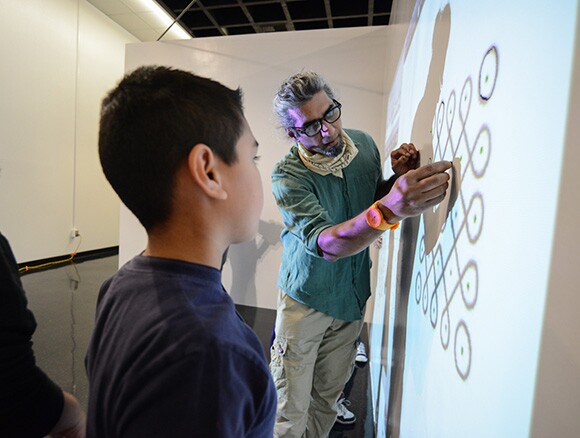Bari Kumar: Remembering the Sacred

Bari Kumar's art has always been about making unexpected connections. East/West is an easy one, since Kumar was born in India but has lived in L.A. since he came here to attend Otis College some 30 years ago. Whether he likes it or not, his work will always be viewed at least partly through that prism. There's some truth to it, but not as much as you might think. Sacred/Profane is another connection that's fairly easy to spot, as his visual sampling references ancient, devotional, art historical sources and events from modern geopolitics and popular culture. In the richly symbolic figurative paintings which he is best known for, he freely incorporates versions of traditional imagery from Eastern and Western art and literature. In his more recent work, in which he constructs images not from paint and brushstrokes, but from thousands of carefully arrayed bolts of richly hued sari-lining cotton, there are other cultural ironies in play.
"Bari Kumar: Remembering the Future" is currently on view at LACMA's satellite gallery inside the Charles White Elementary School in MacArthur Park. For those unfamiliar with the venue, it's an LAUSD school on the grounds of what was once the Otis College campus (its location when Kumar arrived in L.A. to attend the school some 30 years ago), inside of which LACMA operates a curatorial program which involves contemporary programming, loans from the museum's collection, and innovative educational elements for the students. In this case, that means that Kumar's new and recent works are installed alongside ancient statues, textiles, and books from LACMA's South and Southeast Asian Art collection. Dating from the ninth through the early 20th century, and spanning several religious traditions from Christianity to Hinduism and Buddhism, these impressive works are rarely exhibited in any context. Seeing them is its own reward -- but seeing them in intimate proximity to contemporary works they have influenced is a truly unique experience.

Although Kumar is quick to point out that these are not necessarily the literal works he depicts, their presence does a great deal to illuminate the range of his stylistic and iconographic intentions and influences. That said, it's also important to remember that Kumar worked as color supervisor on the Matt Groening animated series "Futurama" for many years -- because a lot of the newest work is based on increasingly abstract ideas about pure color and organic patterns. Then again, it is this purity of nuanced vision when it comes to color that so deeply drews him to India's ubiquitous fabric stores, with their rows and rows of cotton bolts lining the walls with a seemingly infinite array of incremental tones.
Fabric and drapery are pillars of classical art history, used to convey wealth, status, modesty, nobility, religious affiliation, and so on -- and often just as an excuse for grandiose decorative embellishment and visual drama. From Salome's veils to the Mahabharata epic's divine, never-ending sari. Kumar's personal wit is such that he is certainly intrigued by the irony of using using fabric to construct nude portraits -- but also by the way in which using this singular technique in itself forges connections between all the various spheres of his talents and interests. You can see how it's done in this video for his 2009 exhibition, Blind Faith, at the San Jose Museum of Art.
In life as in art, cycles and events generate patterns that are both elusive and impossible to ignore. Moments of serendipity and inspiration occur inside a continuum of fleeting, impermanent experiences. For example, upon discovering that the plexiglas casing for his largest work had cracked in a corner the one that's cracked, Kumar is more likely to think of Duchamp, who upon learning that the same fate had injured his masterpiece, "The Bride Stripped Bare by Her Bachelors, Even," famously remarked, "Well, now it's finally done!" In this spirit, which could rightly be called Duchampian, Kumar, the curators, and the faculty devised a plan to collaborate with the students to create an ephemeral work inspired by the Indian rangoli tradition -- a sort of blessing ritual similar to sand mandalas, in which glyphs and patterns are made as offerings to nature's unseen forces, in the full knowledge that the wind will carry them away and the process must thus be performed daily. Created inside the gallery using traditional colored powder, and augmented by a mesmerizing video, the shapes are repeatedly erased and redrawn by students throughout the duration of the exhibition. The resulting installation is a lively, chaotic but self-organizing affair in which the ritual meaning of the action is clearly privileged over either the perfection or duration of the art.
"Bari Kumar: Remembering the Future," Charles White Elementary School. 2401 Wilshire Blvd. Note to visitors: Because the gallery is located on school grounds, access to the exhibition is limited to the following Public Gallery Hours & Family Days: March 14, April 11, May 9, June 13. 12-4:30pm.


Dig this story? Sign up for our newsletter to get unique arts & culture stories and videos from across Southern California in your inbox. Also, follow Artbound on Facebook, Twitter, and Youtube.